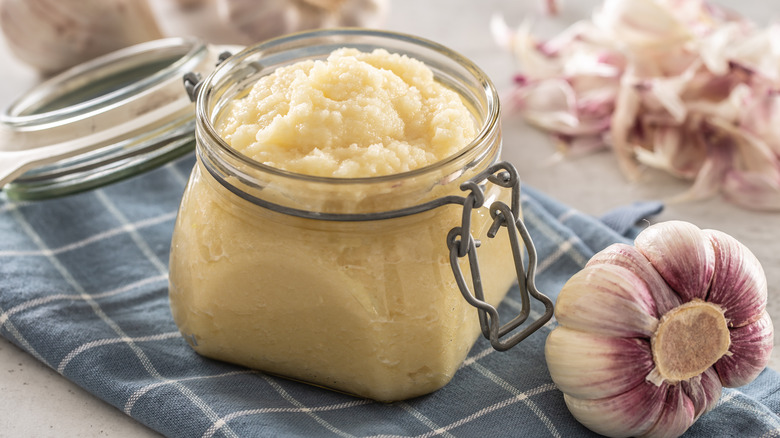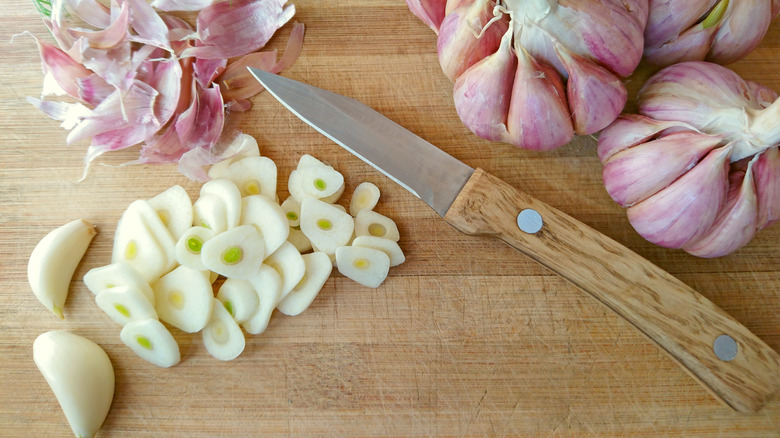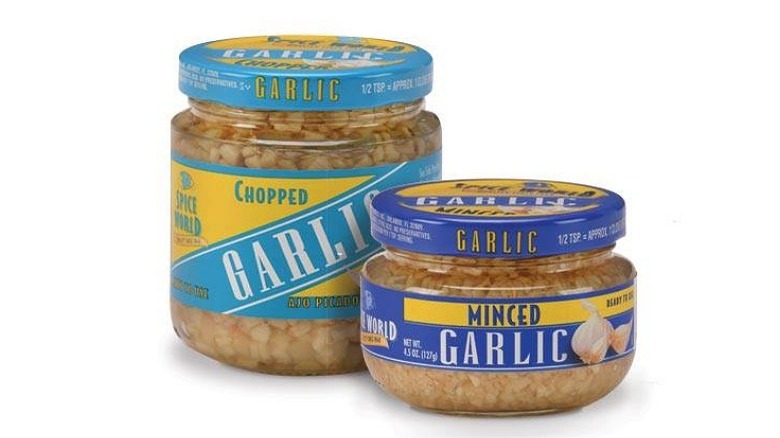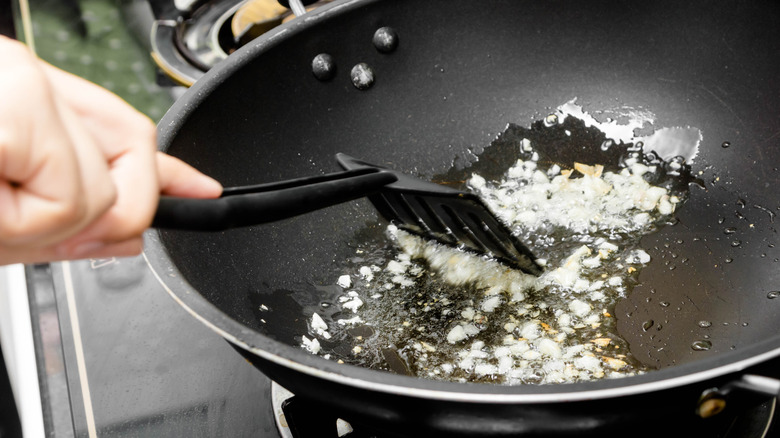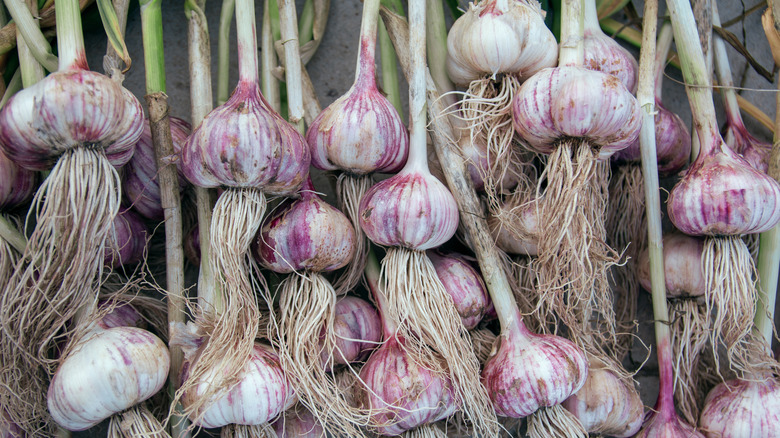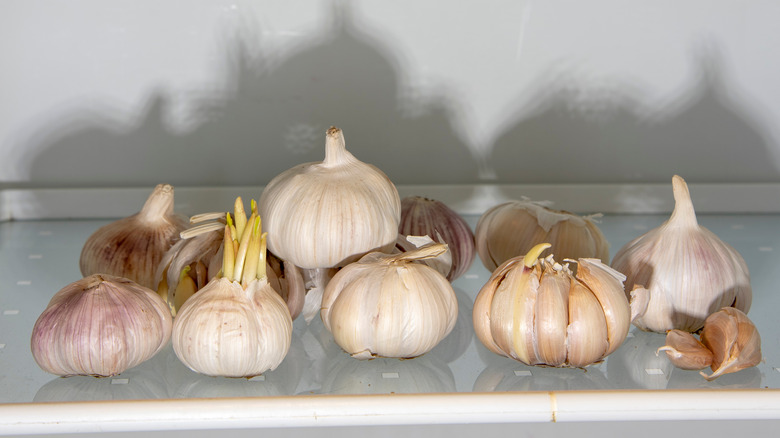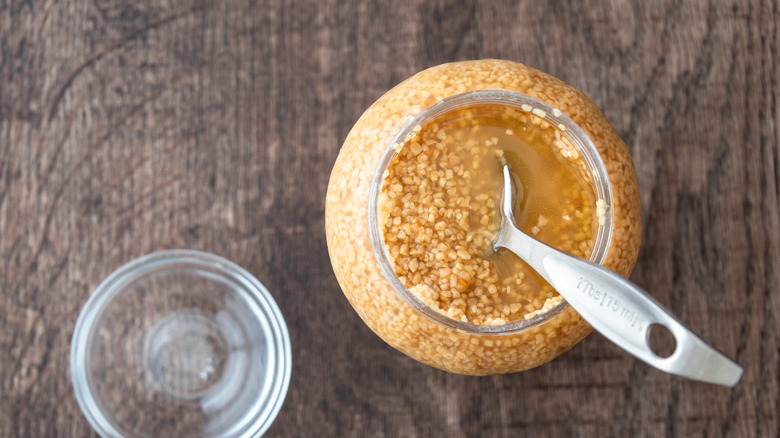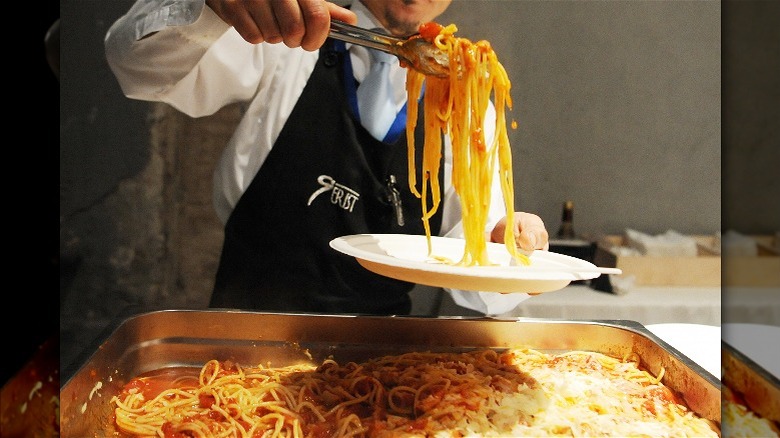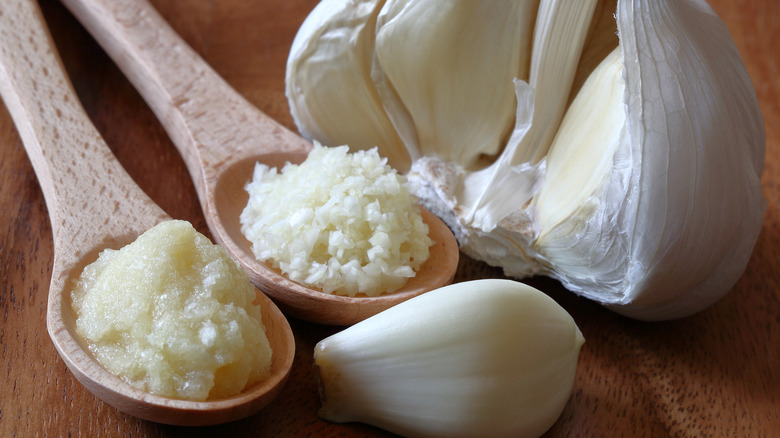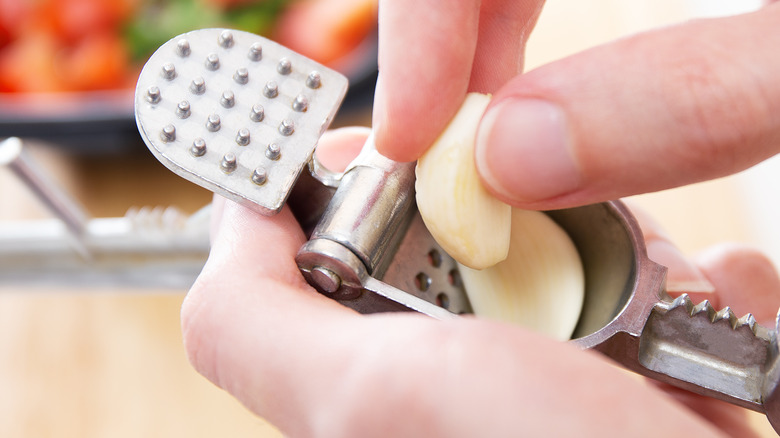What You Need To Know Before Buying Jarred Minced Garlic Again
We may receive a commission on purchases made from links.
Some nights it's a real achievement to actually cook dinner at home and get it on the table. We get it, anything you can do to get from hungry to fed in the most efficient way possible is worth it, which is exactly why jarred minced garlic exists — to make life easier. Even just shaving off an extra two or three minutes that you may be using to peel and chop garlic can make cooking so much less stressful. Not to mention the smell and sticky residue that freshly cut garlic leaves on your hands and cutting board — we understand why many people would rather just scoop out a heaping teaspoon of minced garlic from the jar and get cooking.
But with every shortcut, there are some pitfalls and sacrifices, and pre-minced garlic has a few you should definitely know about. There's a reason (several in fact) that you'll never find a jar of minced garlic in a restaurant kitchen, and why most reputable chefs and cooks will tell you to stick to the fresh stuff. In this article, we'll walk you through what's actually in a jar of minced garlic, how it's different from fresh garlic, and where it comes from, all to help you choose which ingredient is right for you and your next cooking project. Here's everything you need to know before buying another jar of minced garlic.
The flavor of garlic changes quickly once it's cut
It's garlic, so it should taste like garlic, right? Well, like a lot of fresh foods, the flavor begins to rapidly change once you slice into it. According to Jessica Gavin, a certified culinary scientist, a chemical reaction happens when you slice into garlic, which produces the garlicy aroma and flavor we're looking for. "An odorless sulfur-containing amino acid is released from garlic when you rupture the cell walls with a knife," writes Gavin. "The amino acid interacts with a natural enzyme in the garlic called alliinase, and over time they produce a compound called allicin." When you're cooking with fresh garlic, the level of allicin produced provides the best flavor, but the longer minced garlic sits, the more allicin is produced, eventually making it overpowering and imparting a rancid flavor to whatever you cook with it.
Gavin suggests using freshly cut garlic within six hours, otherwise the flavor changes so much that it's unappealing and bitter. So, it's not a stretch to imagine how much the flavor of garlic that has been cut and jarred for a much longer period of time may taste. Jarred minced garlic has a reputation for tasting sour and doing more harm to the dishes you use it in than help. Of course, jarred minced garlic has been preserved with the help of some additional ingredients, but those additives don't stop the production of allicin, they only help to make the garlic more shelf stable.
There's more than just garlic in that jar
When buying a jar of minced garlic, you'll notice that the garlic is packed with liquid. We looked at the ingredient lists for two major minced garlic brands to see what was actually in the jar. Both Goya and Spice World pack minced garlic with water, and Spice World offers a minced garlic that's also soaked in olive oil as well as water. Both brands use different stabilizers for the minced garlic, with Goya choosing to use phosphoric acid and Spice World opting to use citric acid. Phosphoric acid provides a slightly citric fruity taste to the foods it's added to, and is commonly found in sodas, as well as dairy and preserved food products. While phosphorus is something your body needs, the addition of phosphoric acid to processed foods is often more than the recommended daily amount needed.
"Studies suggest that excessive phosphorus intake can put you at risk for osteoporosis and heart disease," per Healthline. "Too much phosphorus can decrease the amount of calcium in your body, leading to bone loss. It can also impair your body's ability to use other minerals, such as iron, zinc, and magnesium." So while phosphoric acid may help keep that minced garlic safe sitting on grocery store shelves, it might not be the healthiest choice for your cooking.
It's already been cooked
It doesn't take much garlic to flavor a dish (unless you're a garlic fanatic and you use double the amount of garlic cloves a recipe calls for — no judgement), and it typically only takes 30 seconds to a minute after it hits the hot pan to become fragrant and begin to season your food. But jarred minced garlic has already undergone an initial cooking phase, which ultimately robs your food of some of that garlicky flavor once it hits your skillet.
In the name of food safety, jarred minced garlic has been pasteurized to make sure it doesn't make you sick — which is obviously a good thing. Now, if you're someone that doesn't really love the flavor of garlic, this might be a bonus for you, but there's a possibility that you don't like the flavor of garlic because you're not using the freshest ingredients. The pasteurization process allows a jar of minced garlic to sit on a store shelf for over a year, but the amount of flavor lost in the process ultimately makes it an inferior ingredient next to vibrant, living, fresh garlic.
It probably traveled a long way to get to you
Believe it or not, the U.S. is the largest importer of garlic in the world, with the majority of the garlic we consume coming from China, Mexico, and Argentina. According to the University of California, China produces a stunning 75% of the world's garlic supply, and is also the source of 75% of U.S. imported garlic. That means it's very likely that the jarred garlic you're consuming has come a very long way to find a place in your kitchen — and if your jar of minced garlic doesn't specify a country of origin, it might be hard to really know where your garlic is coming from. Of course, the farther your food comes from, the more likely it is to be older than locally-grown produce, losing flavor along the way. Not to mention the carbon footprint of shipping such massive quantities of produce across the world. But garlic that's traveled a long way isn't an issue that's relegated to the preserved varieties. There's a good chance that fresh garlic has traveled quite a ways to get to you as well.
The vast majority of garlic produced in the U.S. is grown in California, and to a lesser extent, Oregon and Nevada. Domestic garlic will probably be advertised as such, with "California garlic" used as marketing for a higher-priced product. Areas with thriving farmers markets are also likely to have vendors selling locally-grown garlic which is the freshest garlic you'll lay your hands on.
The garlic may have been chemically treated
Most of the garlic you see whole and in jars at the grocery store is pretty bright white in color, without any brown spots, discoloration, or colorful skin. Like other kinds of produce, garlic comes in several colors including creamy white, brown, and even pink and purple. But if you stop to think about it, it seems a little strange that something that grows in the earth would arrive at the supermarket perfectly white. And the most plausible reason for this anomaly is that it's been chemically treated or bleached. While very few producers outside of the U.S. will openly admit to bleaching their garlic, a report by the European Parliament (a branch of the European Union) suggests that Chinese garlic producers and exporters commonly bleach garlic. Beyond whitening the garlic for visual appeal, the process also kills insects and is used as a pesticide. It's suggested that many of the chemicals used to treat garlic and increase production would not meet safe farming standards in the U.S. and E.U., although it's extremely difficult to regulate.
With that in mind, you might want to consider switching to an organic minced garlic, of which there are more options available than ever before. When looking to buy garlic in stores, look for organic or domestically grown options that are less likely to have been treated with harsh chemicals and pesticides.
Jarred garlic has a longer shelf life than fresh garlic cloves
Whether you're buying jarred minced garlic or fresh bulbs, you might be wondering what the shelf life is for your garlic. A sealed jar of minced garlic should last between 12-18 months, while a whole bulb will stay fresh up to six months if properly stored. But once you pop open that jar or start pulling the cloves off the head of garlic, the clock starts ticking. According to The Fork Bite, you should always consult the date on your jar of garlic, but once it's opened, it has a shelf life of about three months, which is pretty good. Once you tear into a bulb of garlic and begin to expose the cloves, you're looking at an expiration countdown of a couple of weeks.
Neither fresh garlic or a jar of garlic is especially expensive, but you might as well get the most out of your purchase. To make your fresh or jarred garlic last for as long as possible, you can freeze it. According to the Alpha Foodie, you can freeze whole or peeled garlic cloves for three to four months, or even freeze and cut minced garlic or garlic paste.
Jarred garlic can give you botulism
Storing garlic in oil is a longstanding method of home preservation, as well as a way to make a lovely garlic-infused cooking oil. For many who want the convenience of prepared garlic without the hassle of mincing it every time you go to cook, this might seem like a helpful solution to your cooking struggles. But garlic stored in oil runs the risk of developing botulism, which is potentially deadly. A study from Michigan State University found that not only is garlic stored in oil a breeding ground for the botulism bacteria, but it's next to impossible to detect the bacteria by smell or taste.
Even garlic that's been thoroughly washed is at risk. "It is virtually impossible to eliminate all traces of miniscule soil particles on garlic heads," writes Jeannie Nichols for MSU. "These botulinum spores found in soil are harmless when there is oxygen present. But when spore-containing garlic is bottled and covered with oil, an oxygen-free environment is created that promotes the germination of the spores." While store-bought garlic that's packed in water or oil has likely been pasteurized, it still runs the risk of developing botulism if stored improperly. Jarred minced garlic should always be refrigerated once opened, and stored below 50 F — even if its been treated with acids or salts for preservation.
It's best used for large projects
Ultimately, we understand the value of buying jarred minced garlic when it comes to cooking projects that are already going to take a lot of effort. Given what we know about how processed garlic is farmed, stored, and how long the shelf life is for it, it seems like the best uses for the product are for large cooking projects where you'll use a whole jar of minced garlic in one go. Think pasta sauce for a large potluck dinner or garlic bread for a crowd.
Minced garlic is sold in various sizes, from 4 to 32-ounce jars. With that in mind, buy only as much minced garlic as you'll need for one or two large projects, ideally without having any leftover. That way you save the precious minutes that it would otherwise take to mince 8 ounces of garlic and put that time towards getting your big meal on the table and spending time with the people you care about.
Know the whole clove to minced garlic conversion
When using jarred minced garlic in place of fresh garlic, it might be unclear how much garlic to use when a recipe calls for a certain number of cloves. Depending on your cooking style, you might just use the same spoonful of minced garlic for everything you cook, wing it based on the relative size of the recipe, or perhaps you're the kind of cook that likes to have everything measured out according to the recipe. If you're the latter kind of cook, you'll want to know the conversion of jarred minced garlic to fresh cloves. The first place you should check is the side of the jar, as many brands print a conversion on the label. If your jar doesn't have a conversion or you're looking for a more general guideline, Taste of Home suggests that ½ teaspoon of minced garlic is about the same as one clove of garlic. But it's worth pointing out that this particular conversion is by volume, not necessarily by flavor.
As we've discussed, pre-minced garlic has lost some of it's flavor during the pasteurization process, and will likely be a little milder than freshly cut garlic. So, you might want to consider using a teaspoon of garlic per clove, depending on how much you like the taste of garlic.
There are several alternatives to jarred minced garlic
In general, we don't recommend using jarred minced garlic unless you're cooking for a large crowd and the time and effort you save is more substantial. But for a regular weeknight meal, we understand that you still want to save as much valuable time and energy as you can. Fresh organic garlic will give your food the best flavor, but there are some other options you can consider if you'd like to move away from jarred minced garlic for convenience.
Whole peeled garlic is also available at many grocery stores, and saves you the effort of individually peeling a handful of garlic cloves. You just take them out of the bag and pop them in your garlic press. In less than a minute you've got freshly minced garlic without the fuss of peeling garlic. Many restaurants also purchase garlic pre-peeled to take advantage of fresh garlic flavor without sacrificing time unpeeling thousands of cloves of garlic.
If you want to avoid the smell and stickiness of garlic altogether, you'd probably do well cooking with garlic powder, garlic flakes, or even garlic salt to help season your meals, without the overwhelming notes that drive some people away from garlic altogether. There are also plenty of gadgets on the market to help make peeling, chopping, and mincing fresh garlic a snap, without having to sacrifice flavor in the process.
